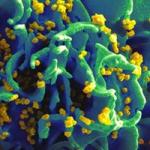
Research Topics
Currently our Section concentrates on investigation of the quality of crystal and cryoEM structures deposited in the Protein Data Bank, with the aim of flagging models that exhibit problems such as poor fit to the map, missing water molecules, improperly modeled ligands, or even duplicated entries.
Crystallographic Studies of Proteases and Their Inhibitors
Crystallographic studies of proteases had been in the past an important area of research of this Section. We have been particularly active in the investigation of structure-function relationship in aspartic proteases, including clinically important retroviral enzymes. We have investigated structure-function relationship in retroviral proteases from several sources, such as HIV-1, FIV, RSV, EIAV, HTLV-1, and XMRV. Cockroach allergen Bla g 2 was shown to be an inactive aspartic protease and we solved its structure by itself, and in a complex with several specific antibodies. We have determined the structure of a unique histoaspartic protease, an enzyme with the pepsin fold, but a vastly different mechanism. We have been investigating serine-carboxyl peptidases (sedolisins), a family that was first characterized based on crystal structures solved in this laboratory and that is found in many different organisms.
We were also investigating the bacterial ATP-dependent protease Lon, having found that its proteolytic domain has a unique fold and thus establishes a new family of proteases with a Ser-Lys catalytic dyad. We have solved the structures of the proteolytic domain of A and B type Lon proteases, encoded by E. coli and Archaeoglobus fulgidus, as well as the N-terminal and α domains of E. coli Lon. We have been engaged in structural and biochemical studies of serine protease inhibitors EcTI,BbKI, and CrataBL, the latter being both an inhibitor and a lectin with potent anticancer properties.
Our extramural collaborators include Mariusz Jaskolski, D.Sc., Adam Mickiewicz University, Poznan, Poland; Wladek Minor, Ph. D., University of Virginia, Charlottesville, VA; and Tatyana Rotanova, D.Sc., Shemyakin-Ovchinnikov Institute of Bioorganic Chemistry, Moscow, Russia.
Biography
Dr. Wlodawer received his Ph.D. from the University of California, Los Angeles, in 1974. Having completed his postdoctoral training at Stanford University, he joined the National Bureau of Standards in 1976, then moved to the ABL-Basic Research Program at the NCI-FCRDC in 1987. From October 1998 to March 1999, he was on sabbatical as an elected Visiting Fellow of Sidney Sussex College, University of Cambridge.
Dr. Wlodawer served as Chief of the former Macromolecular Crystallography Laboratory, CCR, NCI from 1999-2020. Dr. Wlodawer is Doctor Honoris Causa of the Technical University of Lodz, Poland. He was elected Foreign Member of the Polish Academy of Sciences in 2005, is a recipient of the 2006 NCI Mentor of Merit Award, was awarded the Heyrovsky Honorary Medal by the Czech Academy of Sciences in 2008, and is a recipient of the 2024 Casimir Funk Award. He is a member of the American Crystallographic Association and was elected ACA Fellow in 2013. He has served as an Editor of the FEBS Journal since 2007, as an Associate Editor of FEBS OpenBio since 2011, and as Editor-in-Chief of the Current Research in Structural Biology since 2022.
Selected Publications
- Li M, Dimaio F, Zhou D, Gustchina A, Lubkowski J, Dauter Z, Baker D, Wlodawer A. Crystal structure of XMRV protease differs from the structures of other retropepsins. Nat Struct Mol Biol. 2011;18(2):227-9.
- Bujacz G, Jaskólski M, Alexandratos J, Wlodawer A, Merkel G, Katz RA, Skalka AM. High-resolution structure of the catalytic domain of avian sarcoma virus integrase. J Mol Biol. 1995;253(2):333-46.
- Miller M, Jaskólski M, Rao JK, Leis J, Wlodawer A. Crystal structure of a retroviral protease proves relationship to aspartic protease family. Nature. 1989;337(6207):576-9.
- Wlodawer A, Miller M, Jaskólski M, Sathyanarayana BK, Baldwin E, Weber IT, Selk LM, Clawson L, Schneider J, Kent SB. Conserved folding in retroviral proteases: crystal structure of a synthetic HIV-1 protease. Science. 1989;245(4918):616-21.
Related Scientific Focus Areas
This page was last updated on Monday, April 28, 2025

